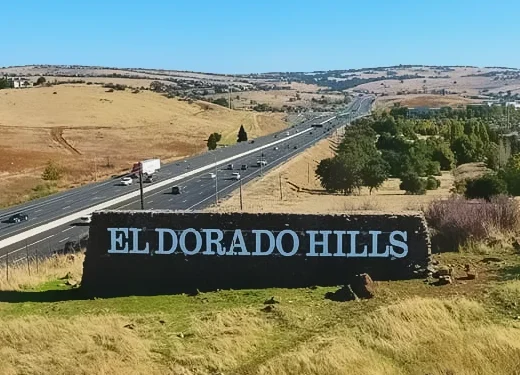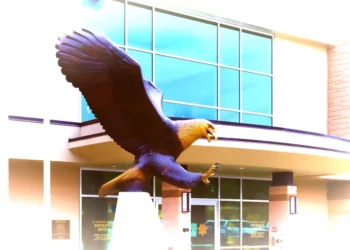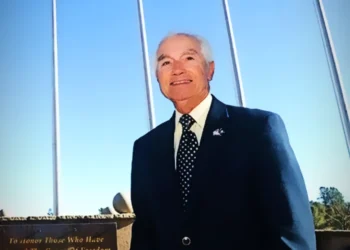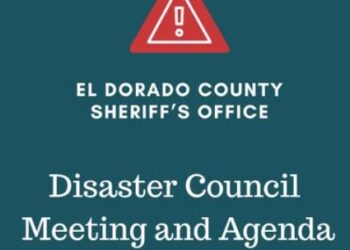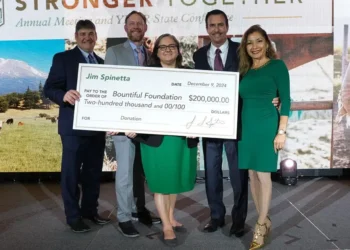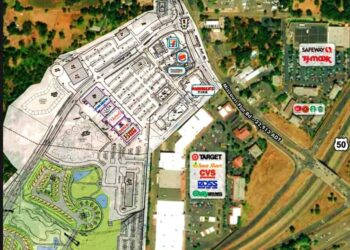By Cris Alarcon, InEDC Writer. (May 26, 2025) UPDATED May 28
El Dorado Hills, Calif. — A group of El Dorado Hills residents has stepped up to preserve a cherished piece of the community’s mid-century history—the El Dorado Hills Monument Sign—ensuring the landmark will continue to welcome travelers along Highway 50 for years to come.
Constructed in the early 1960s as part of the community’s original design, the sign stands at the gateway to the Rolling Hills Community Services District. El Dorado Hills itself was envisioned by developer Allan Lindsey and designed by architect Victor Gruen, who pioneered the modern shopping mall. Unlike many nearby towns rooted in Gold Rush history, El Dorado Hills was a planned suburban development—making landmarks like the Monument Sign especially significant to its sense of identity.
In recent years, the sign had deteriorated due to weather and aging infrastructure. With limited funds available, the Rolling Hills CSD faced difficulty maintaining it. That’s when residents formed the “Save Our Sign” Committee, a volunteer group determined to keep the sign standing strong.
“We don’t have century-old buildings here,”
said committee member Diane Kellogg.
“But we do have our history—and that sign is part of it. It deserves to be restored and preserved.”
In partnership with the El Dorado Hills Community Foundation, the committee raised over $7,500.
The beloved roadside landmark marking the gateway to El Dorado Hills has been fully restored and preserved thanks to the determined efforts of local volunteers, construction professionals, and the Rolling Hills Community Services District.
The El Dorado Hills Monument Sign, originally constructed in the early 1960s, had stood for decades on the southern edge of Highway 50. It was built during the planned development of El Dorado Hills, spearheaded by developer Allan Lindsey and master planner Victor Gruen, best known for designing America’s first enclosed shopping mall. While lacking the Gold Rush-era charm of neighboring towns, El Dorado Hills has crafted its own symbols of identity—chief among them, this mid-century monument.
By 2020, the Monument Sign had fallen into disrepair. The Rolling Hills CSD, which oversees the land, faced funding limitations, prompting concerned residents to form the “Save Our Sign” Committee, a grassroots group that partnered with the El Dorado Hills Community Foundation to raise restoration funds.
Through their efforts, over $7,500 was raised, enabling a Phase One restoration project in 2021. According to updates from the group, the project included structural evaluations from sign industry professionals, civil engineers, and masonry experts. These professionals concluded that filling structural voids within the wall and re-mortaring the stone veneer would restore integrity and ensure the sign’s longevity.
By the end of 2021, the sign’s structural restoration was completed.
“Once the work was done, our job was to protect it,”
said a spokesperson from the committee. In 2022, after initial “No Trespassing” signs were vandalized, more vandal-resistant signage was installed, and by year’s end, construction and security fencing was removed in collaboration with the Rolling Hills CSD.
Since 2022, the “Save Our Sign” group has not undertaken any additional work. The committee’s mission—to preserve the sign for future generations—was accomplished through a combination of community fundraising, professional restoration, and civic coordination.
The El Dorado Hills Monument Sign now stands as more than a historical marker—it’s a symbol of what determined citizens can achieve together. Additional updates, photos, and historical context can be found on the committee’s Facebook page at facebook.com/EDHSign.
The Monument Sign has long served as a symbolic entrance to the community—its modest structure standing as a nostalgic reminder of El Dorado Hills’ early development. While other towns boast century-old storefronts or mining relics, El Dorado Hills has built its traditions around landmarks like this, as well as the beloved “El Dorado Hills Rocks”—boulders painted by residents to mark birthdays, tributes, and community spirit, including a lasting patriotic display after September 11, 2001.
In the heart of El Dorado Hills, some of the most enduring landmarks carry the quiet signature of a master craftsman—
Our Papou, Peter Kleary, built these monument signs. My husband is a third generation mason. Operated as Kleary Masonry, sold that company five years ago and just reopened another masonry company, K2. We have lived in EDH for over fifteen years. Peter just turned 98, lives in Folsom and is in great health! He will love to hear this.
said Diana Kleary
For more information about the restoration, or to contribute to ongoing preservation efforts, residents are encouraged to visit www.edhsign.org

